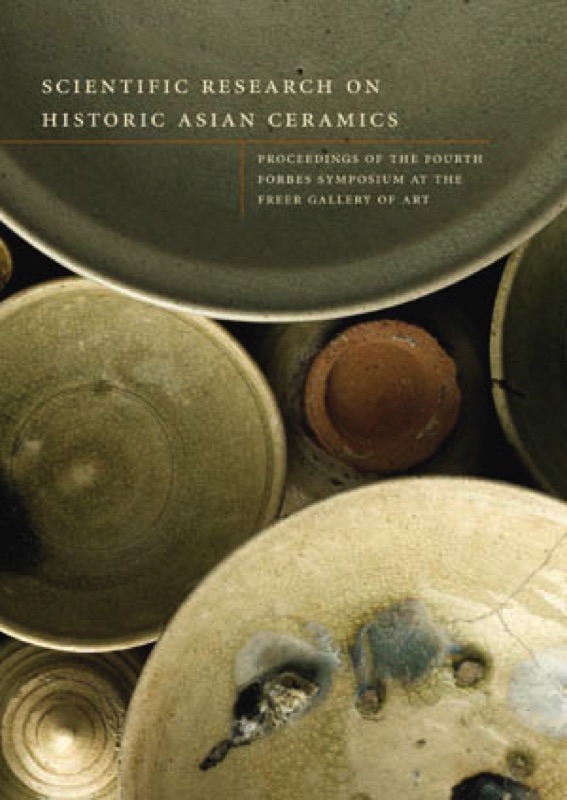Asian ceramics in their many forms and functions - utilitarian, aesthetics, and religious - are the subject of this volume. Through analysis of their composition, technology, typology, and use, researchers from all over the world who met for a conference at the Freer Gallery of Art define ceramic technologies, examine their similarities and differences, and explore broader questions regarding their historical and cultural context, such as trade and technology transfer between East and West Asia. Topics include Myanmar ceramics, Seljuq tiles, Korean and Chinese high-fired ceramics, Chinese and Japanese lead-glazed wares, Chinese funerary sculptures, Khmer kilns, and the study of ceramics through inscriptions.
This volume is the fourth in a series of Forbes Symposium proceedings. All four volumes are published by Archetype Publications in association with the Freer Gallery of Art, Smithsonian Institution.
Proceedings of the fourth Forbes Symposium at the Freer Gallery of Art
Foreword
Acknowledgments
List of contributors
Introduction
Technology and Provenance
Scientific analysis of glazed tile from the Seljuq Palace of Kubad-Âbâd, Lake Beysehir, Turkey
Ian C. Freestone, Zehra Yegingil, and Rüçhan Arik
The Study of Pyu Ceramics from ancient Pyu Cities in Myanmar (Burma)
Nyunt Han
Comparative study of cobalt blue pigment on Chinese blue-and-white porcelain and Islamic glazed pottery, thirteenth-seventeenth centuries
Rui Wen and A.M. Pollard
Analysis of Persian painted Minai ware
Kerith Koss, Blythe McCarthy, Ellen Salzman Chase, and Dylan Smith
Stoneware and Porcelain
Study of the composition and microstructure of Koryo celadon and whiteware from the kiln complex at Bangsan Village, Kyonggi Province, Korea
Carolyn K. Koh Choo, Choo Woong Kil, Ahn Sang Doo, Lee Young Eun, and Kim Gyu Ho
The provenance of ancient Chinese proto-celadon
Wang Changsui and Zhu Jian
Microstructures of Chinese green-glazed porcelains from Ru Guan kiln and Laohudong Guan kiln
Li Weidong, Luo Hongjie, and Li Jiazhi
Scientific study of porcelain from the Lingwu kiln of Xixia dynasty in Ningxia, China
Song Yan and Ma Qinglin
Technological innovation in the manufacture of white porcelain in North China
Zhu Tiequan, Wang Changsui, Mao Zhenwei, Yao Zhengquan, Pan Weibin, and Xue Bin
Research on the question of dating Chinese famille noire porcelain
Linda Rosenfeld Pomper, Jeffrey P. Stamen, and Norman R. Weiss
Han, Tang, and contemporaneous ceramics
Mingqi pottery buildings of Han dynasty China: production methods and techniques
Guo Qinghua
The spread of pottery miniatures in Han dynasty China
Kawamura Yoshio
Characteristics of tricolored earthenware from the Huangye kiln site and the Heijo capital site determined by nondestructive analysis
Furihata Junko and Tatsumi Junitiro
The latest archaeological discoveries of Tang sancai in China and the study of provenance
Cheng Qian and Lei Yong
Mutual influence and imitation of Mesopotamian and Chinese ceramics in the ninth and tenth centuries
Sasaki Tatsuo
Production and distribution
Defining a new type of Japanese 'folk' ceramic: Nishi Sarayama ware
Andrew L. Maske
The impact of imitation ceramic industries and internal political restrictions on Chinese commercial ceramic exports in the Indian Ocean maritime exchange, ca. 1200-1700
Rahul Oka, Laure Dussubieux, Chapurukha M. Kusimba, and Vishwas D. Gogte
Characterizing Asian stoneware jar production at the transition to the Early Modern Period, 1550-1650
Peter Grave and Michael Macceroni
Khmer Ceramics
New data on the distribution of Khmer ceramic kilns and the study of ceramics
Ea Darith
Preliminary results of the Anlong Thom kiln excavation on Phnom Kulen in Angkor: a case study of ALK01
Chhay Visoth, Chhay Rachna, San Kosal, Sok Hun Ly, and Tabata Yukitsugu
Rethinking Khmer ceramics and metal vessels through ancient inscriptions and bas-reliefs: Khmer ceramic typology through ancient words
Sok Keo Sovannara
